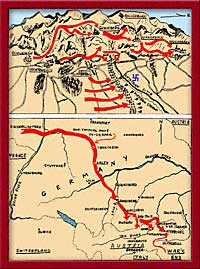
ARDENNES - ALSACE
CAMPAIGN
BREAKTHROUGH INTO GERMANY
 When the 36th Division began its attack on 15
March it was the division farthest from the Siegfried Line and was not expected to attack
it. That task was planned as the Army’s main effort many miles to the 36th’s
left. Consequently the 36th was not provided with siege guns to reduce the defenses of the
Siegfried Line. It was expected only to make a serious demonstration before the
fortifications. The heavy Siegfried fortifications were a formidable obstacle, especially
in the 7th Army sector. The familiar pyramidal obstacles (dragon’s teeth) stretched
across the plain from Ober-Otterbach to Steinfeld before the 36th Division. They were
covered by fire from overlooking heights where a complex network of heavy, concrete
pill-boxes, set into the ground and well camouflaged, included elaborate systems of
trenches and wire obstacles. Three months earlier, other 7th Army troops had spent three
weeks trying to force an opening through the Line, without success. When the 36th Division began its attack on 15
March it was the division farthest from the Siegfried Line and was not expected to attack
it. That task was planned as the Army’s main effort many miles to the 36th’s
left. Consequently the 36th was not provided with siege guns to reduce the defenses of the
Siegfried Line. It was expected only to make a serious demonstration before the
fortifications. The heavy Siegfried fortifications were a formidable obstacle, especially
in the 7th Army sector. The familiar pyramidal obstacles (dragon’s teeth) stretched
across the plain from Ober-Otterbach to Steinfeld before the 36th Division. They were
covered by fire from overlooking heights where a complex network of heavy, concrete
pill-boxes, set into the ground and well camouflaged, included elaborate systems of
trenches and wire obstacles. Three months earlier, other 7th Army troops had spent three
weeks trying to force an opening through the Line, without success.
However, when the 36th captured Wissembourg and rolled up to the Siegfried Line it was
not to be stopped. The 142nd Regiment’s 1st Battalion, weary from the previous
day’s long pursuit and fighting, was in a lead position and was immediately ordered
toward Bergzabern and into the Siegfried Line. Schweigen and Rechtenbach were easily taken
but the approach to Ober-Otterbach was met by intense enemy fire. By nightfall, however,
the town was taken and other battalions of the Division were moving over the hills,
engaging enemy pillbox defenses. The break came on 20 March when the 3rd Battalion of the
142nd, after a twelve hour climb through rugged hills, captured Grassberg Heights — a
key enemy defense, whose capture paved the way for collapse of the Siegfried Line, in the
Division zone. Bitter fighting continued until on 21 March the 36th broke out of Grassberg
to seize Darrenbach and press on into the key town of Bergzabern, over 2½ miles behind
the Siegfried Line. Meanwhile the Division was demolishing pillbox after pillbox against
stubborn defenders. On 22 March Germans who had not been able to flee began surrendering
by the hundreds. Pockets of entrenched resistance continued to resist the American advance
both within the depth of the Siegfried Line and beyond it. Before dawn on 24 March the
36th was on the Rhine having captured ferry sites, thousands of prisoners and huge stocks
of supplies and equipment. This was the last great battle in which the 36th Infantry
Division and its attached units would be engaged.
On 30 March the 7th Army’s General Patch issued an Order of the Day, saying,
All officers and men are congratulated on the recent operations of 7th Army
personnel".
The 443rd Battalion S-2 report showed prisoners taken by the Battalion in March as:
Battery A - 15; Battery B - 85; Battery C - 40; Battery D - 18
Battalion Headquarters - 5
|